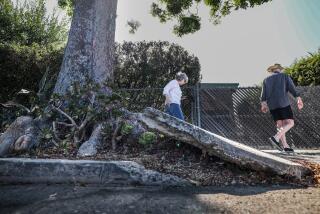Monumental Task : City Is Studying Each of Its Outdoor Statues So It Can Better Preserve Them
- Share via
His face is showing a few lines. And it’s splotched with a few unsightly age spots.
Still, Abraham Lincoln looks pretty good for someone whose 187th birthday is commemorated today.
At least that is the diagnosis of experts who have given Lincoln a first-of-a-kind physical exam at Lincoln Park, 2 1/2 miles east of downtown Los Angeles.
The depiction of the 16th president is a 10-foot bronze statue that serves as a centerpiece for the 46-acre park. Honest Abe also is helping launch an unusual survey of all outdoor public sculpture in the city.
Art experts have begun scrutinizing the 100 statues and 75 contemporary sculptures owned by the city to determine their condition. The findings will be used to create Los Angeles’ first statue-preservation program.
Unlike some East Coast cities, Los Angeles is not loaded with renderings of generals on horses and politicians on pedestals. But it has silent film star Rudolph Valentino standing in marble and bronze in Hollywood’s De Longpre Park and pioneer aviator Amelia Earhart portrayed in fiberglass and steel outside the North Hollywood library. Mexican revolutionary leader Emiliano Zapata stands guard in a Mission Street traffic island near Boyle Heights.
Experts say the relative lack of memorials is due to the fact that Los Angeles didn’t start to really grow until after the heyday of heroic statuary.
“This was a small place until the turn of the century. Interest in memorial statues started declining in this country after about 1910,” said Michael Several, who is coordinating the sculpture survey.
Several, a paralegal and history buff who lives in Highland Park, runs a nonprofit group called Urban Art Inc. The group has received a $15,000 contract from the city to start the survey by examining artwork at Lincoln and MacArthur parks.
*
The inspections have come on the heels of a national “Save Outdoor Sculpture” statue-counting project conducted by volunteers that found there are about 800 public sculptures in the Los Angeles area.
Two professional art conservators are in charge of the inspections. As part of their assessment, they are recommending restoration procedures for damaged pieces and offering strategies for long-range protection of the others.
City officials plan to use the information to train park workers how to properly clean statues. Later, they hope to organize volunteers to watch over the pieces.
“We want to get groups to ‘adopt’ sculptures,” said Jennifer Easton, curator with the Cultural Affairs Department’s public arts division.
In the past, she said, civic groups and veterans organizations that donated statues or busts for the city to display rarely provided cash for future upkeep.
“When people give us a statue now, we’re adamant about them also providing for long-term maintenance,” Easton said.
Art conservators Rosa Lowinger and Glenn Wharton, Los Angeles-based experts who are doing the assessments, said many of the 28 sculptures inspected so far are in good shape. That’s because Los Angeles’ weather is kind to statues. And they are surprisingly graffiti-free.
The landmark Lincoln statue, for example, only needs a gentle scrubbing with a soft-bristled brush dipped in distilled water and a neutral detergent to remove mottled discoloration caused by pigeon droppings and lawn sprinkler spray.
After that, a couple of layers of a special wax applied by brush and then buffed out with lint-free towels will restore its original luster, according to the experts.
“It can be done in two days with $20 worth of materials,” Wharton said.
The statue, depicting Lincoln as a young lawyer, is based on a life mask and photographs taken at the time of his inauguration. It was created in 1926 by acclaimed Los Angeles sculptor Julia Bracken Wendt. Considered the city’s leading sculptor during the first half of the century, Wendt was trained by famed Illinois sculptor Lorado Taft.
Wendt added a rich green patina to the bronze when she cast it. But improper cleaning techniques could easily destroy that distinctive coating, warned Lowinger. That is what happened to a bust of Gen. Ignacio Zaragoza in Lincoln Park’s “El Parque de Mexico” commemorative area. Zaragoza led Mexican forces in their Cinco de Mayo victory over the French in 1862.
“Somebody came in here thinking it needed cleaning and they took the patina off,” Lowinger said. The scrubbing removed a light-green covering on the 15-year-old bronze, leaving the general with a garishly yellow face. “It was a well-intentioned effort. But it has to be fixed.”
Some statues are in such bad shape that drastic measures will be required to repair them, according to Lowinger and Wharton. Those that cannot be restored to the look intended by their artist will be removed, city officials have decided.
A 59-year-old concrete statue of nurse Florence Nightingale--which stood at a local hospital until it was donated to the city and moved to Lincoln Park in 1974--has had its arms and nose broken off and its descriptive plaque stolen.
The two art experts say statuary and sculpture at MacArthur Park west of downtown is in worse shape than Lincoln Park’s. Many of the pieces there are more contemporary and made from easily damaged materials such as fiberglass and rust-prone metal.
But pigeons and people are statues’ biggest enemy at MacArthur Park, according to Wharton and Lowinger.
More to Read
The biggest entertainment stories
Get our big stories about Hollywood, film, television, music, arts, culture and more right in your inbox as soon as they publish.
You may occasionally receive promotional content from the Los Angeles Times.











